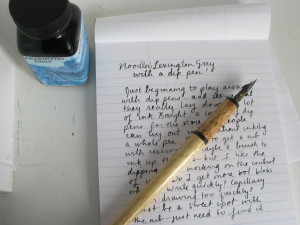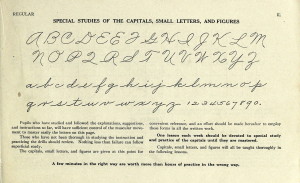 What are the mechanics of writing? I’m not thinking of what English teachers are looking for: spelling, grammar, capitalization. I’m describing the kinesthetic movement of a pen across paper as ideas flow from the mind in time with the forearm. The pen responds to pressure points on the inner middle finger, the bottom of the thumb, and the pad of the forefinger. Applying this subtle pressure, and coordinating my thoughts in time with my wrist’s slow movement across the page, allows me to express myself.
What are the mechanics of writing? I’m not thinking of what English teachers are looking for: spelling, grammar, capitalization. I’m describing the kinesthetic movement of a pen across paper as ideas flow from the mind in time with the forearm. The pen responds to pressure points on the inner middle finger, the bottom of the thumb, and the pad of the forefinger. Applying this subtle pressure, and coordinating my thoughts in time with my wrist’s slow movement across the page, allows me to express myself.
Recently I heard a lecture by the novelist and travel writer, Paul Theroux. He spoke at the Huntington Library, where they have collections of manuscript, from Henry Thoreau to Abraham Lincoln to James Joyce to Jack London. Rather than promote his latest book, Deep South, he spoke about the work of writing.
 He is 70-something now, and recalled the time in 1st grade, 65 years ago, when he was taught the mechanics of writing. In his small schoolhouse in Massachusetts, they used metal nibs and inkwells. The students were taught strokes of making letters and words (the Palmer Method), but they also learned the physics of holding the pen, dipping the nib into the ink, lifting the pen without dribbling the ink, and writing as much as they could until the ink ran out. They repeated this act, lifting, dipping, writing; lifting, dipping, writing, as they held onto their thought, re-engaging with their ideas as they developed a rhythm when writing.
He is 70-something now, and recalled the time in 1st grade, 65 years ago, when he was taught the mechanics of writing. In his small schoolhouse in Massachusetts, they used metal nibs and inkwells. The students were taught strokes of making letters and words (the Palmer Method), but they also learned the physics of holding the pen, dipping the nib into the ink, lifting the pen without dribbling the ink, and writing as much as they could until the ink ran out. They repeated this act, lifting, dipping, writing; lifting, dipping, writing, as they held onto their thought, re-engaging with their ideas as they developed a rhythm when writing.
Mr. Theroux described the “flow,” the orchestrated timing which influenced the student’s thinking, and the physical act of writing, where there were necessary pauses while the nib absorbed more ink before the though could continue. The executive functions of sustained attention, planning and prioritization, working memory, and goal-directed persistence were exercised along with the pursuit of expressing ideas.
Given this somewhat messy process, it was required to re-copy your first draft onto fresh paper as the “fair copy.” And this is the rewarding part of writing for Mr. Theroux: inevitably, his ideas improved as he re-examined them, correcting errors of the first attempt. Not wanting to re-copy your work a third time meant honing your writing to commit succinct ideas to paper. This process of making a fair copy built critical thinking skills, and I presume challenged your working memory, as you compared the sentence you were working o to the entire thesis or topic.
The fair copy became your personal artwork. The formation of your letters, the spacing of words, sentences and paragraphs, were part of the physical expression of who you were – your ideas, your soul.
Mr. Theroux lamented the loss of the individual expression with the advent of typewriters and word processors. The uniqueness of a person’s cursive is wiped away. But even more than that, he regretted the loss of the careful thought, and the choreography between the brain, the hand, the pen and the paper.
Simultaneously, I thought of my students, who dread writing. It starts with the mechanical act: discomfort when balancing a pen in the crux between the fingers and the thumb; unsatisfactory letter formation; the very imperfect-looking page which looks ugly and babyish compared to their peers; and the emotional feeling of “diving off the cliff” when turning it in for the teacher’s scrutiny and probable negative opinion.
These students may never experience ideas flowing from their hearts into their fingertips and out onto paper for others to appreciate. And given the new tool of a keyboard, their flow is constantly interrupted by red and green squiggles, announcing their frequent errors… which are so intolerable that they have to correct them mid-thought, losing their train of thought. Writing, too, gets distracted by the tools that help typical learners, but not them.
Children today may be developing a different way of expressing themselves, perhaps by speaking their ideas, expressing themselves verbally or visually, using assistive technology, not expecting a printout as their final expression. When attempting to write a 5-paragraph essay by hand, their first effort is so difficult, and interrupted so frequently, that they are too tired and too late to enjoy the act of producing a fair copy.
While I wait to understand and appreciate what their electronic version of writing will look like, I am quietly disturbed by the idea that some abilities are lost by the lack of writing by hand. Research done by Pam Mueller, The_Pen_Is_Mightier_Than_The_Keyboard_Ad, shows how college students retain more of what they learn in lectures by writing hand-written noes as opposed to typing them on a keyboard. The act of writing is integral to constructing knowledge, just as a physical signature holds people more accountable and honest than an electronic one (NPR story on electronic signatures, 10/22/15).
While I continue to encourage my students to use assistive technology to capture their ideas, I do not want to deprive them the experience of producing a fair copy. How to do this? Foremost it demands allowing more time – probably twice as much time – to re-read one’s work, probably aloud. One has to use metacognitive abilities to check each sentence against the main idea or thesis to check that it is connected. Could re-typing the entire essay produce similar result as a handwritten fair copy? And could I ever get buy-in from a student to do that? Most suffer from procrastination as well as fear when it comes to writing, so it is usually “good enough” to submit the first draft.
Hopefully we can start by teaching students to appreciate the quality of writing done by authors such as Mr. Theroux, to understand the difference between “output” and eloquence. This means, of course, that students need to read… more, a lot more. They need to hear the cadences in literature to write it in their own. Hopefully internalizing those rhythms of language can occur from listening, just listening, if reading is arduous and working memory is impacted, or other distractions impede upon lengthy reading sessions. We can’t insist that all students should be trained with nibs and inkwells, but we must insist that they express themselves, and to train themselves to do so clearly, succinctly and coherently. We know that old technology could produce writers; we must use mental pressure to create adequate expressions with our new tools.